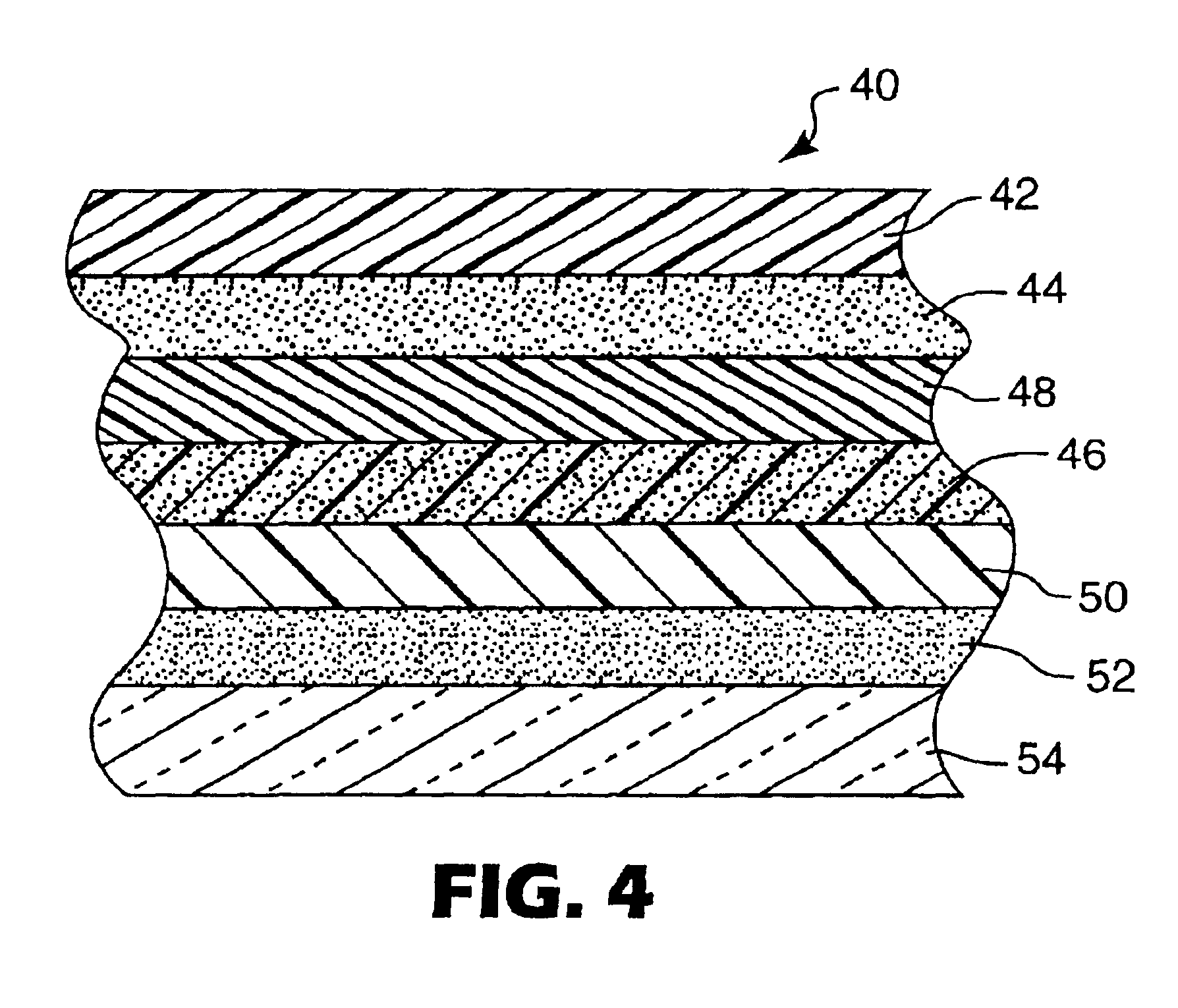Hybrid adhesives, articles, and methods
- Summary
- Abstract
- Description
- Claims
- Application Information
AI Technical Summary
Benefits of technology
Problems solved by technology
Method used
Image
Examples
examples
[0085]These examples are merely for illustrative purposes only and are not meant to be limiting on the scope of the appended claims. All parts, percentages, ratios, etc. in the examples and the rest of the specification are by weight unless indicated otherwise.
[0086]
Table of AbbreviationsAAAcrylic acidMAMethyl AcrylateBAn-Butyl AcrylateAR FilmAntireflective film as described in USpatent number 6,277,485 column 13 line60-column 14 line 39, with a sheetresistance of 65 ohm / square.PolycarbonatePolycarbonate film of 70 μm thicknessRetardation Filmfrom Teijin IndustriesGlass Microscope75 millimeter × 50 millimeter × 1Slidemillimeter Corning No. 2947 MicroSlidescommercially available from CorningGlass Works; Corning, NYIOAIsooctyl acrylateIRGACURE 651Photoinitiator 2,2 dimethoxy-2-phenylacetophenone, available from Ciba;Hawthorne, NJPETpolyester film of polyethyleneterephthalateMVTRMoisture Vapor Transmission RateBostik AdhesiveA polyester based adhesive coated out ofmethyl ethyl ketone s...
examples 1-7
COMPARATIVE EXAMPLES C1-C2
Adhesive Preparation
[0096]In a brown glass reaction vessel was placed Anthracene, RHODORSIL 2074 and Ethyl Acetate in the amounts shown in Table 1. Once all of the solids were dissolved, Polyacrylate A was added and the resulting mixture was mixed well. To this mixture was added either EPON 828 or ERL 4221 and TTE in the amounts shown in Table 1.
[0097]
TABLE 1EPONERLRhodorsilPolyacrylateEthyl Acetate8284221TTE2074AnthraceneEx.A (grams)(grams)(grams)(grams)(grams)(grams)(grams)196.050.02.3400.250.380.10296.050.04.6900.250.380.10396.050.09.3800.250.380.10496.050.012.5000.250.380.10596.050.017.5000.250.380.10696.050.021.0000.250.380.10796.050.0017.50.250.380.10C196.050.025.0000.250.380.10C296.050.031.0000.250.380.10
Laminate Preparation
[0098]After mixing, this solution was coated onto the non-metallized side of an AR Film, dried at 70° C. for 10 minutes to yield a 37.5 μm thick dry PSA tape. Samples of this PSA tape were laminated onto a Polycarbonate Plate, PMM...
examples 8-11
COMPARATIVE EXAMPLE C3
Adhesive Preparation
[0106]In a brown glass reaction vessel was placed Anthracene, RHODORSIL 2074, Irgacure 651, and Ethyl Acetate in the amounts shown in Table 7. Once all of the solids were dissolved, Polyacrylate A was added and the resulting mixture was mixed well. To this mixture was added ABP, TMPTA, EPON 828 and TTE in the amounts shown in Table 7.
[0107]
TABLE 7EthylIrgacureRhodorsilPolyacrylateAcetate651ABPTMPTAEpon 828TTE2074AnthraceneEx.A (grams)(grams)(grams)(grams)(grams)(grams)(grams)(grams)(grams)896.050.00.251.00.509.380.250.380.10996.050.00.502.04.6021.000.250.380.101096.050.00.502.09.2021.000.250.380.101196.050.00.502.013.8021.000.250.380.10C396.000000000
Laminate Preparation
[0108]After mixing, this solution was coated onto the non-metallized side of an AR Film, dried at 70° C. for 10 minutes to yield a 37.5 μm thick dry PSA tape. Samples of this PSA tape were laminated onto a Polycarbonate Plate, PMMA Plate or Glass Microscope Slide. After 24 hou...
PUM
| Property | Measurement | Unit |
|---|---|---|
| Temperature | aaaaa | aaaaa |
| Temperature | aaaaa | aaaaa |
| Fraction | aaaaa | aaaaa |
Abstract
Description
Claims
Application Information
 Login to View More
Login to View More - R&D
- Intellectual Property
- Life Sciences
- Materials
- Tech Scout
- Unparalleled Data Quality
- Higher Quality Content
- 60% Fewer Hallucinations
Browse by: Latest US Patents, China's latest patents, Technical Efficacy Thesaurus, Application Domain, Technology Topic, Popular Technical Reports.
© 2025 PatSnap. All rights reserved.Legal|Privacy policy|Modern Slavery Act Transparency Statement|Sitemap|About US| Contact US: help@patsnap.com



